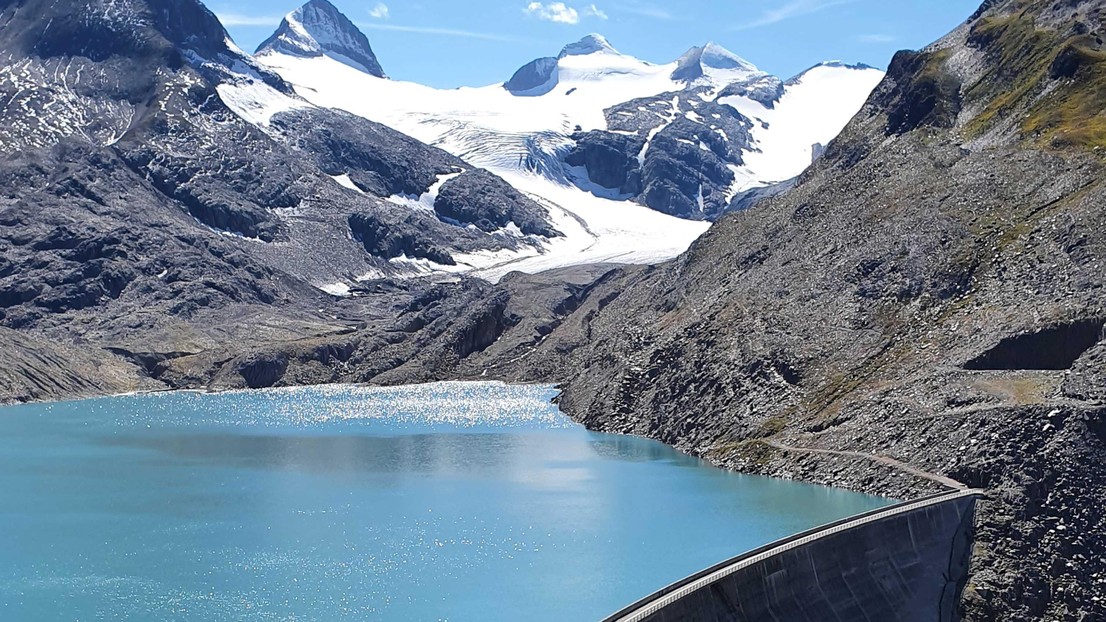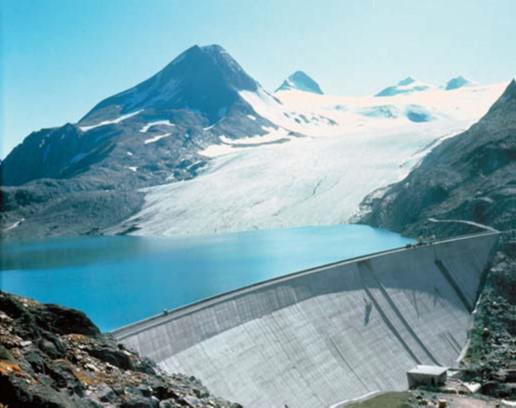
The Gries glacier and dam in 2020. © Andrea Baumer
An EPFL engineer has illustrated some of the complex ways in which climate change will affect hydropower facilities, taking the Gries dam in Valais Canton as a case study.
Many of the consequences of climate change - such as glacier melting (to the point where they'll soon disappear), increasingly rare snowfall, higher levels of winter rainfall, and more frequent droughts - will have a profound impact on the water reservoirs at Switzerland's hydropower plants and how this water is used. "For now, and barring a few exceptions, this water has value only in terms of its ability to generate hydropower," says Giovanni De Cesare, a civil engineer and head of operations at EPFL's Hydraulic Constructions Laboratory (PL-LCH). "But we need to also give it an economic value based on the different ways it can be used. In the future, dams will serve a variety of purposes."
That's the conclusion of a study De Cesare published recently in AGU Books. For his research, he conducted a literature review and crunched through datasets from recent years on climate change, glacier evolution and reservoir sedimentation to outline scenarios for the challenges that dam operators could face going forward. In Switzerland, for example, glaciers have almost halved in size over the past 100 years and most of them will probably disappear by 2100.

De Cesare focused his study on the Gries dam in Valais Canton, whose reservoir is located at an altitude of 2,387 meters. This water cascades through a series of hydropower plants and eventually flows into Lake Maggiore, after generating around 3% of Switzerland's total hydropower. To put this in perspective, hydropower accounted for approximately 57.6% of the electricity produced in the country in 2023. De Cesare's study bears the provocative title "What will disappear first, the Glacier or the Reservoir?" and highlights how urgently action is needed at both a political and technical level to preserve reservoirs and prevent conflicts about how the water is used.
Substituting for the glacier
The answer to De Cesare's question is straightforward, at least for the Gries dam: the reservoir will last longer than the glacier, which is predicted to disappear by around 2070. Once that happens, the reservoir will be fed only by rainfall, snowfall and melting snow. By 2100, around 30% less water will be flowing into the reservoir relative to current levels. Yet the reservoir will have to substitute for some of the role currently played by the glacier. When it comes to how the reservoir water will be allocated, however, that's an open question.
Switzerland, with its approximately 220 dams, is at a turning point. Sediment has accumulated in many of its reservoirs, reducing their storage capacity and disrupting the production of hydropower. At the same time, several dams see their dead storage filled with sediment, which has been estimated after 50 years (the Gries dam went into service in 1966). Swiss law requires dam operators to restore their facilities to safe, standard operating conditions before their concession agreements can be sold or renewed. As a result, many dams must be renovated, in some cases elevated, and some of the sediment that has collected at the bottom of their reservoirs - creating what's known as "dead storage volume" - must be removed to improve the dam's functioning and the safety of drawdown operations. But global warming has added an unknown to the equation: what happens when the glaciers - which were one of the reasons why the dams were built in the first place - disappear? And how can civil engineers incorporate this prospect into their renovation work?
Major changes will take place between now and the end of the century, even though there's no clear consensus on the issue
Dramatic, unpredictable changes
De Cesare cites another study which concludes that the consequences of global warming will be dramatic.* "Major changes will take place between now and the end of the century, even though there's no clear consensus on the issue," he says. The Gries dam has already experienced some of these changes, as reported in De Cesare's study. "Before, the Gries glacier released a fine sediment known as glacier milk," he says. "But now, it's depositing moraine material that's accumulating to form a delta. For now, the moraine is sitting on the sides of the glacier, but the heavy rainfall that's predicted to occur in the future could flush the moraine down into the reservoir." This would impede the proper functioning of the dam. Another unknown is how the rising tree line will affect the soil at higher altitudes: either the presence of trees will stabilize the soil, or, in areas with thawing permafrost, the trees will promote erosion and make areas unsafe. In addition, new lakes will undoubtedly form where the glacier used to be.
In-depth studies
De Cesare has been researching hydropower systems for nearly 30 years and meets with dam operators regularly as part of this work. "Today I'm calling on them to take action because all the elements are now in place," he says. "The funding to renovate dams is available and the necessary technology exists. Now the ball is in their court. Some dam operators have started moving, but progress overall is too slow."
De Cesare goes on to explain that dam operators shouldn't be the only ones who decide how reservoir water is allocated to different services - hydropower generation, artificial snow, biodiversity preservation, Alpine farming, nuclear reactor cooling, manufacturing, drinking water, and replenishment of aquifers, for example - as the seasons change. "That's why I believe in-depth studies are needed on how the water in each reservoir can best be used," says De Cesare. "Germany went through this exercise with the national water strategy it adopted in 2023, which outlined scenarios for various extreme events. In Switzerland, we're running behind."**
*Herman, F., De Doncker, F., Delaney, I., Prasicek, G. and Koppes, M. (2021). "The impact of glaciers on mountain erosion." Nat Rev Earth Environ 2, 422-435. DOI:10.1038/s43017-021-00165-9
**A member of Switzerland's lower house of parliament filed a postulate with the Swiss Federal Council to examine the possibility of developing a national water strategy in order to manage conflicts of interest. The Federal Council responded in August 2023, saying that such a strategy wasn't necessary because sufficient funds and resources had been allocated to the cantons.






